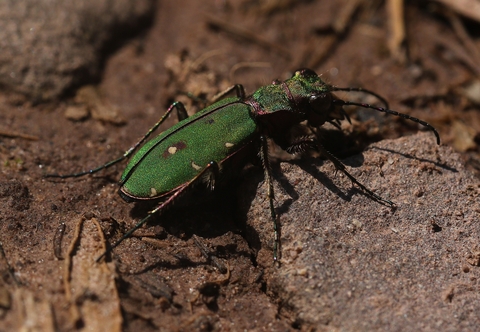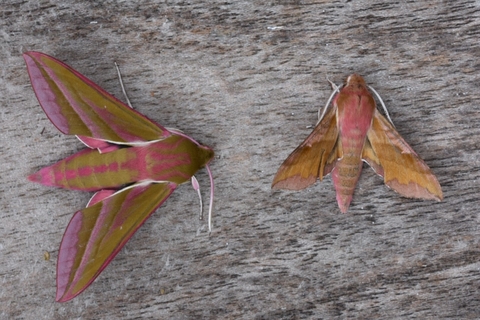In July, even garden moth traps will often contain a Ruby Tiger: though the unique ruby red colour is more recognisable than any obviously tigerish nature. If you don’t have your own moth trap, look out for public sessions run by GWT and other organisations; hang a sheet up overnight, lit by a strong torch; or just look around the outside of lit windows.
Year of the Tiger
Andrew Cormack
Andrew Cormack
Ruby Tiger Moth
Maybe a small fluffy moth doesn’t satisfy: can we find a proper, fierce, predator? If you’re an ant or other small insect then a Tiger Beetle is definitely a scary creature to be avoided. Look out for them in open sunny places in spring and summer; Gwent’s former industrial landscapes should be good locations. You need to be quick though as they run fast, both to catch their own prey and to avoid being eaten by others. The metallic green colour is, like the tiger’s coat, surprisingly good camouflage in their grassland homes.

Andy Karran
Tiger Beetle
If you were puzzled why the Ruby Tiger deserved its name at all then its larger relative, the Scarlet Tiger, may seem more appropriate. These are big triangular moths, greenish black with a variable pattern of cream and white blotches. The hindwings are usually covered when the moth is resting, but give a bright flash of scarlet as it takes off, or when it flicks its wings to alarm a potential predator. These are one of the few moths that are expanding their range and population in the UK; they are active during the day in late June, so you may spot them near marshes or rivers. If you’re down on the Gwent coast, look out for the Jersey Tiger, a recent arrival from further south and east.
Andrew Cormack
Scarlet Tiger Moth
But shouldn’t a tiger have stripes? That brings us to one of Gwent’s most spectacular moths – the Garden Tiger. These are seriously impressive insects: 45-65mm across – bigger than most butterflies – with a body that’s bulky even in proportion to the wings. I’m half-asleep when I check my moth trap around dawn in June and July, so seeing one of these looking back at me was a dramatic wake-up. Garden Tigers are even brighter than Scarlet ones: the forewings are a tangle of black patches and white lines, the hindwings red, orange or yellow with large blue and black spots. In one respect, however, these moths are about as far as you can get from a hungry tiger: many of the adults don’t eat at all, with all the feeding and growing being done at the caterpillar stage.
Andrew Cormack
Garden Tiger Moth
If you’ve enjoyed these “big game” expeditions, those caterpillars may suggest some more. Because of their hairiness and size, they are often called Wooly Bears. If you find one munching on nettle or dock leaves, don’t disturb its life-long meal; the hairs are a defence against predators and can even irritate human skin if you touch them.
So: tigers…, bears…, what else? How about elephant: another large moth, this time pink and orange, whose caterpillar looks like a trunk complete with eye? Or wolf, a group of garden spiders that chase and pounce on their prey? I’m sure you can think of others…

Andrew Cormack
Large and small Elephant Hawk Moths

